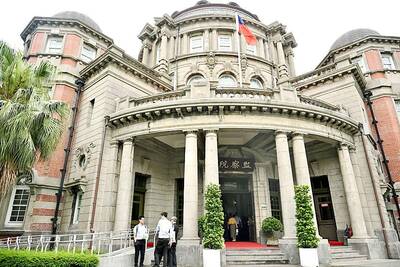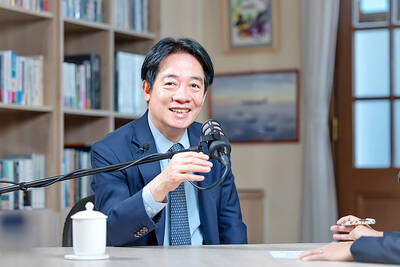For Indian brides buying jewelry, the bigger the better is the general rule, but record gold prices during this year’s wedding season are forcing many to compromise.
India is the world’s biggest consumer of gold, so the rise of local prices to records above US$1,000 an ounce (28g) is keenly felt here — and nowhere more so than in the jewelry shops, an obligatory stop before any ceremony.
While few women are prepared to trade down on the size of their purchases, some are turning to new designs that retain the bulk and glitz but use less of the precious metal.

PHOTO: AFP
Leading gold retailers in New Delhi and Mumbai say they are flooded with requests by clients for cheaper necklaces, rings, earrings, bangles or armbands.
“Clients come, select the design and tell us to make it with less gold,” said a store manager at Mehrasons, a leading gold shop in New Delhi, who asked not to be named because he was not authorized to speak to the media.
Gold has cultural and religious significance for Indians — considered auspicious and a sign of wealth and prosperity.
Traditionally, daughters from the majority Hindu population are given gold ornaments at the time of their marriage.
The gold is known as streedhan, or women’s wealth, and most families will spend as much as they can afford.
“Big pieces of jewelry mean high gold content, but that is no longer affordable,” said Prabhu Thakkar, a gold trader based in Mumbai’s Jhaveri Bazaar, a wholesale market for gold and silver.
“Indians are never happy with small, delicate designs. They need glossy, thick jewelry,” he said. “For Indians, big is beautiful.”
One solution is to buy big pieces but designed differently with lower gold content.
Some jewelry manufacturers are importing technology and alloys from Europe to make ornaments using hollowing techniques that help them reduce gold content by up to 50 percent.
Using the modern techniques, goldsmiths are trained to flatten 22-carat gold and then stuff it with an alloy that is a mix of copper and silver to make the ornament heavy.
“I have purchased Italian machinery and hired foreign designers to work on Indian designs using electroforming and hollow techniques,” said Ritesh Jain, of Aurogold, a manufacturing and retailer in Mumbai.
“People in India are always keen to buy gold but they cannot afford huge quantities these days. We have found new methods to move our stock quickly,” Jain said.
His company is investing more than US$100,000 to buy and install the new machinery.
Calvin John, a brand manager of Tanisq, a gold retail chain owned by the Tata conglomerate, said the trend of using gold in smaller quantities picked up after 2004, when the price of the precious metal began rising.
“We have to surprise people by showing them big pieces come with a low price tag,” he said.
Local prices of gold, which have accelerated to highs in line with international prices, rose by 9 percent in the third quarter of this year, the World Gold Council said in a report released on Thursday.
The report said that retail investment in India — investment in gold bars or coins — fell 67 percent over 12 months to 26 tonnes in the third quarter to September as high prices and a poor monsoon dented consumer sentiment.
Jewelry demand fell 42 percent to 111.6 tonnes, while total demand, which comprises jewelry and retail investment demand, fell 49 percent to 137.6 tonnes.
India usually imports between 700 tonnes and 800 tonnes of the metal every year and accounts for about 20 percent of global demand.
In recent weeks, international gold prices have blazed a record-breaking trail on concerns about the declining strength of the dollar as the world’s reserve currency.
For brides-to-be shopping during India’s ongoing wedding season, which runs from November to the end of January, the high prices are a headache.
“We have to wear a lot of jewelry. The bride should always look special,” said Nupur Varshney, a 25-year-old teacher who will be tying the knot in January.

Nvidia Corp yesterday unveiled its new high-speed interconnect technology, NVLink Fusion, with Taiwanese application-specific IC (ASIC) designers Alchip Technologies Ltd (世芯) and MediaTek Inc (聯發科) among the first to adopt the technology to help build semi-custom artificial intelligence (AI) infrastructure for hyperscalers. Nvidia has opened its technology to outside users, as hyperscalers and cloud service providers are building their own cost-effective AI chips, or accelerators, used in AI servers by leveraging ASIC firms’ designing capabilities to reduce their dependence on Nvidia. Previously, NVLink technology was only available for Nvidia’s own AI platform. “NVLink Fusion opens Nvidia’s AI platform and rich ecosystem for

WARNING: From Jan. 1 last year to the end of last month, 89 Taiwanese have gone missing or been detained in China, the MAC said, urging people to carefully consider travel to China Lax enforcement had made virtually moot regulations banning civil servants from making unauthorized visits to China, the Control Yuan said yesterday. Several agencies allowed personnel to travel to China after they submitted explanations for the trip written using artificial intelligence or provided no reason at all, the Control Yuan said in a statement, following an investigation headed by Control Yuan member Lin Wen-cheng (林文程). The probe identified 318 civil servants who traveled to China without permission in the past 10 years, but the true number could be close to 1,000, the Control Yuan said. The public employees investigated were not engaged in national

CAUSE AND EFFECT: China’s policies prompted the US to increase its presence in the Indo-Pacific, and Beijing should consider if this outcome is in its best interests, Lai said China has been escalating its military and political pressure on Taiwan for many years, but should reflect on this strategy and think about what is really in its best interest, President William Lai (賴清德) said. Lai made the remark in a YouTube interview with Mindi World News that was broadcast on Saturday, ahead of the first anniversary of his presidential inauguration tomorrow. The US has clearly stated that China is its biggest challenge and threat, with US President Donald Trump and US Secretary of Defense Pete Hegseth repeatedly saying that the US should increase its forces in the Indo-Pacific region

ALL TOGETHER: Only by including Taiwan can the WHA fully exemplify its commitment to ‘One World for Health,’ the representative offices of eight nations in Taiwan said The representative offices in Taiwan of eight nations yesterday issued a joint statement reiterating their support for Taiwan’s meaningful engagement with the WHO and for Taipei’s participation as an observer at the World Health Assembly (WHA). The joint statement came as Taiwan has not received an invitation to this year’s WHA, which started yesterday and runs until Tuesday next week. This year’s meeting of the decisionmaking body of the WHO in Geneva, Switzerland, would be the ninth consecutive year Taiwan has been excluded. The eight offices, which reaffirmed their support for Taiwan, are the British Office Taipei, the Australian Office Taipei, the